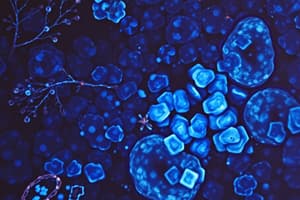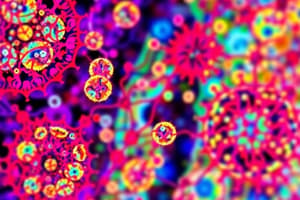Podcast
Questions and Answers
What is the simplest collection of matter that can live?
What is the simplest collection of matter that can live?
- Organ
- Cell (correct)
- Tissue
- Organism
What does a light microscope magnify, and what are its limitations?
What does a light microscope magnify, and what are its limitations?
It magnifies effectively but has resolution issues and is limited by the shortest wavelength of light.
Define magnification in relation to microscopy.
Define magnification in relation to microscopy.
Ratio of the object's image size to its real size.
What is resolution in microscopy?
What is resolution in microscopy?
What does an electron microscope focus?
What does an electron microscope focus?
What is the function of a scanning electron microscope?
What is the function of a scanning electron microscope?
What is the primary use of a transmission electron microscope?
What is the primary use of a transmission electron microscope?
What does cell fractionation do?
What does cell fractionation do?
What is the function of a centrifuge in a laboratory?
What is the function of a centrifuge in a laboratory?
What is cytosol?
What is cytosol?
List two characteristics of prokaryotic cells.
List two characteristics of prokaryotic cells.
What is the nucleoid?
What is the nucleoid?
What are pili?
What are pili?
What is the function of a cell wall?
What is the function of a cell wall?
List three characteristics of eukaryotic cells.
List three characteristics of eukaryotic cells.
What does cytoplasm refer to?
What does cytoplasm refer to?
What is the plasma membrane?
What is the plasma membrane?
What is the fundamental structure of a membrane?
What is the fundamental structure of a membrane?
What is the function of the central vacuole in plant cells?
What is the function of the central vacuole in plant cells?
What are plasmodesmata?
What are plasmodesmata?
What does the nuclear envelope do?
What does the nuclear envelope do?
What is a pore complex?
What is a pore complex?
Describe the nuclear lamina.
Describe the nuclear lamina.
What are chromosomes made of?
What are chromosomes made of?
What is ribosome's role in the cell?
What is ribosome's role in the cell?
What are free ribosomes?
What are free ribosomes?
What are bound ribosomes?
What are bound ribosomes?
What is the function of a peroxisome?
What is the function of a peroxisome?
What role do mitochondria play in the cell?
What role do mitochondria play in the cell?
What is the role of lysosomes?
What is the role of lysosomes?
What is apoptosis?
What is apoptosis?
What is the function of the Golgi apparatus?
What is the function of the Golgi apparatus?
Flashcards are hidden until you start studying
Study Notes
Cell Basics
- Cells are the simplest living units, enclosed by a plasma membrane and containing chromosomes.
- Prokaryotic cells lack a nucleus and consist of bacteria and archaea; they have a nucleoid region for DNA.
- Eukaryotic cells possess a true nucleus with a membrane and include protists, fungi, animals, and plants.
Microscopy
- Light microscopes magnify samples but have resolution limitations, suitable for studying live cells.
- Electron microscopes utilize electrons for imaging, offering greater detail with two types: Scanning (3D images) and Transmission (ultrastructure, non-living specimens).
Cellular Components
- Cytosol is the semi-fluid matrix within a cell's membrane.
- Cytoplasm refers to the entire region between the nucleus and plasma membrane.
- Ribosomes are responsible for protein synthesis, found as free-floating or bound to the endoplasmic reticulum.
- Mitochondria convert organic material into ATP, serving as the cell's power plant.
Organelles and Structures
- The plasma membrane acts as a selective barrier, controlling the passage of substances.
- The central vacuole in plant cells stores water, contributing to cell structure and turgor.
- Lysosomes contain digestive enzymes for breaking down waste and cellular debris.
- Peroxisomes help detoxify harmful compounds, especially hydrogen peroxide, prevalent in liver cells.
Nuclear Structure
- The nuclear envelope encloses the nucleus and features a lipid bilayer structure.
- Pore complexes within the envelope regulate the movement of macromolecules between the nucleus and cytoplasm.
- The nuclear lamina supports the nucleus's shape with a net-like array of protein filaments.
Genetic Material
- Chromosomes carry genetic information and are composed of chromatin, a combination of DNA and proteins.
- The nucleolus, situated within the nucleus, is essential for ribosome synthesis.
Additional Cell Features
- Cell walls in plants provide structure and rigidity, composed mainly of cellulose.
- Plasmodesmata are channels in plant cell walls that facilitate communication and transport of materials between cells.
- Pili on prokaryotic cells enable the exchange of genetic material and information.
Membrane Structure
- Membranes consist of a phospholipid bilayer with integrated proteins (cholesterol, glycoproteins, glycolipids) that contribute to cellular organization and functions.
Studying That Suits You
Use AI to generate personalized quizzes and flashcards to suit your learning preferences.




